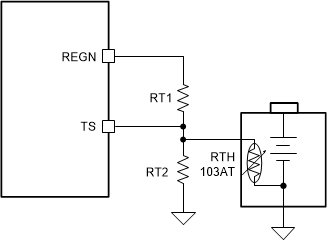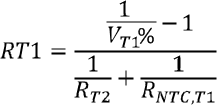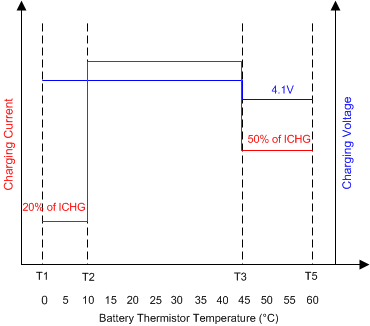JAJSKR2 February 2021 BQ25303J
PRODUCTION DATA
- 1
- 1 特長
- 2 アプリケーション
- 3 概要
- 4 Revision History
- 5 概要 (続き)
- 6 Device Comparison Table
- 7 Pin Configuration and Functions
- 8 Specifications
-
9 Detailed Description
- 9.1 Overview
- 9.2 Functional Block Diagram
- 9.3 Feature Description
- 9.4 Device Functional Modes
- 10Application and Implementation
- 11Power Supply Recommendations
- 12Layout
- 13Device and Documentation Support
- 14Mechanical, Packaging, and Orderable Information
9.3.2.6 Thermistor Temperature Monitoring
The charger device provides a single thermistor input TS pin for battery temperature monitor. To improve the safety of charging Li-ion batteries, JEITA guideline was released on April 20, 2007. The guideline emphasized the importance of avoiding a high charge current and high charge voltage at certain low and high temperature ranges. To initiate a charge cycle, the voltage on TS pin must be within the VT1% to VT5% thresholds. If TS voltage is out of T1-T5 temperature range, the charger stops charging and waits until the battery temperature is within the T1 to T5 range. .
At cool temperature (T1-T2), the charge current is reduced to 20% of the set fast charge if RICHG < RICHG_HIGH. If RICHG > RICHG_HIGH, the charge current is reduced to 50% of fast charge current in cool charge. At normal temperature (T2 - T3), the charger charges battery as fast charge and the fast charge current is set by a resister at ICHG pin. At warm temperature (T3 -T5), the charge voltage is reduced to 4.1 V and 50% of fast charge current. If the charge voltage is set below 4.1V, the charge voltage will remain unchanged during warm charge.
RT1 and RT2 programs temperatures from T1 to T5. In the equations, RNTC,T1 is NTC thermistor resistance value at temperature T1 and RNTC,T5 is NTC thermistor resistance values at temperature T5. Select 0°C to 60°C for battery charge temperature range, then NTC thermistor 103AT-2 thermistor resistance is RNTC,T1 = 27.28 kΩ ( at 0°C) and RNTC,T5 = 3.02 kΩ (at 60°C), from the Equation 1 and Equation 2, RT1 and RT2 are derived as:
• RT1 = 4.32 kΩ
• RT1 = 21 kΩ
 Figure 9-2 Battery Temperature Sensing
Circuit
Figure 9-2 Battery Temperature Sensing
Circuit

 Figure 9-3 JEITA Profile
Figure 9-3 JEITA Profile